Distributed Formation Control with Obstacle and Collision Avoidance for Hypersonic Gliding Vehicles Subject to Multiple Constraints
Abstract
Multiple hypersonic gliding vehicles’ (HGVs’) formation control problems with obstacle and collision avoidance are investigated in this paper, which is addressed in the stage of entry gliding. The originality of this paper stems from the formation control algorithm where constraints of dynamic pressure, heating rate, total aerodynamic load, control inputs, collision avoidance, obstacle avoidance, and the terminal states are considered simultaneously. The algorithm implements a control framework designed to be of two terms: distributed virtual controller and actual control input solver. The distributed virtual controller is based on distributed model predictive control with synchronous update strategy, where the virtual control signals are derived by the optimization simultaneously at each time step for each HGV under directed communication topology. Subsequently, according to the virtual control signals obtained, a coupled nonlinear equation set is solved to get actual control signals: each HGV’s bank angle together with the angle of attack. The actual control input solver adopts a feasible solution process to calculate the actual control signals while dealing with constraints. Finally, extensive numerical simulations are implemented to unveil the proposed algorithm’s performance and superiority.
1. Introduction
Hypersonic glide vehicles (HGVs), which exhibit high speeds, strong maneuverability, and controllable trajectories, have acquired significant attention in recent years [1, 2]. The flight process of HGVs consists of four stages: the adjustment stage, the powered stage, the entry gliding stage, and the terminal guidance stage [3]. The longest working range and duration make the entry gliding phase of HGVs a significant focus of attention in its flight process. In [4], to safely direct the vehicle to the intended terminal point under specified conditions, an entry guidance system is set. For HGV which has high ratios of lift-to-drag, a viable entry flight trajectory with three-degree-of-freedom is created via combining real-time updated commands from the adaptive guidance approach proposed in [5]. The guidance system employs analytical schemes for a 3-D hypersonic gliding trajectory, allowing for rapid onboard planning of reference trajectories. As a result, it exhibits exceptional computational efficiency, as studied in [6–8]. Some novel hybrid algorithms are evolved for real-time trajectory planning of a single HGV during the reentry phase, which offers improved reliability for online applications [9, 10]. Extensive research on the entry gliding phase has demonstrated the significant controllability of the entry trajectory. Furthermore, many entry trajectory planning algorithms have emerged to address diverse mission requirements under increasingly complex environments. Consequently, exploring new operational paradigms for HGVs during the entry gliding phase holds immense significance.
Compared to a single HGV, employing a cooperative strategy for HGVs can bring significant improvements in efficiency, information sharing, and robustness. Coordinating HGVs to arrive at the same target simultaneously with varied trajectories are a commonly encountered challenge during the cooperative flight of multi-HGVs. Significant progress has been made through the application of modern approaches including the impact time control approach [11], consensus-based guidance [12], and trajectory planning approach [13], which have yielded interesting results. In [14, 15], the focus is on achieving precise control over both the timing and angle of impact for multiple HGVs. Through merging the decentralized and centralized communication topologies, an integrated framework for the cooperative guidance presented in [16] addressed the challenge of cooperative attack with multimissiles on a single stationary target. In [17], the design and analysis of a distributed cooperative guidance strategy of encirclement hunting for multivehicles in a leader-follower coordination structure are investigated, which effectively engages and tracks a maneuvering target using a cooperative approach. Due to the challenges associated with handling complex dynamics and underactuated problems brought by HGVs, there is limited research dedicated to the HGVs’ formation control. In [18], with normal positions as the coordination variables, the second-order consensus protocol is implemented to the formation controller. Following multiple HGVs’ formation flight framework, with the hierarchical control theory, the fixed-time stability is used for a globally fixed-time formation control scheme [19]. Considering the lack of thrust to counteract the complicated impact for lateral maneuvers of longitudinal motion, a feasible flight mode called rendezvous and formation flight mode is raised [20], where the corresponding guidance strategy is set as a combination of online guidance and offline planning. According to the methods presented in [18–20], various flight modes are utilized to address the challenge of formation control for multiple HGVs. These methods aim to generate and maintain desired formation configurations by an online algorithm and only depend on the neighbor-to-neighbor communication. It means that it is being called upon to require an online algorithm with faster computing power and a smaller communication load for multiple HGVs’ formation control. Furthermore, due to the complexity of the dynamics involved, the formation controllers designed by the above methods may have limited consideration for certain constraints. Therefore, studying formation control with multiple constraints for HGVs is indeed important and intriguing.
Considering the practical applications of HGVs, it is crucial to account for multiple constraints that must be satisfied during the entry gliding phase. Trajectory constraints for HGVs arise from various hardware limitations and factors related to the vehicle’s dynamics, aerodynamics, and thermal characteristics, such as state and control constraints, overload constraints, dynamic pressure constraints, and aerodynamic thermal constraints. One way to handle the complicated multiple flight constraints is the introduction of the quasi equilibrium gliding condition [21]. In [22], under complicated multiconstraint, the trajectory optimization problems were transformed to the problems of nonlinear optimal control, which were handled with Gauss pseudospectral method. In [23], researchers focused on studying the analytical solution for the HGVs’ gliding problem, which aimed to develop a solution that allows for real-time boundary corridors along with control variables that can be online corrected. Furthermore, the stochastic gradient PSO method [24, 25] together with the pigeon-inspired optimization method [26] has been proven to be useful in acquiring optimal trajectories that satisfy multiple constraints. In [24], for hypersonic glide vehicles under significant constraints, the stochastic gradient particle swarm optimization (SGPSO) method is employed as a global optimization method to quickly produce smooth and feasible trajectories. Firstly, a velocity-dependent profile for bank angle is devised to narrow down the search space for parameters using the constrained particle swarm optimization method. Then, the reentry constraints are carried out by assigning an infinite fitness function value when particles exceed the maximum allowable values [25]. By incorporating control profiles, the entry trajectory optimization question is effectively addressed using the pigeon-inspired optimization (PIO) algorithm [26]. This approach allows for the determination of control profiles that satisfy equilibrium glide conditions, terminal conditions, and a range of load factor constraints while also minimizing the peak heat rate. Meanwhile, mission constraints such as specifying a particular destination or satisfying a particular flight trajectory are requirements that depend on different missions [27]. The collision and obstacle avoidance problem is a fundamental research area in the domain of multiagent systems and has recently acquired significant attention in the robotics and control system communities. In [28], with the employment of uncertainty and disturbance estimator (UDE), the paper investigated a distributed formation control strategy for unmanned marine surface vehicle (MSV) system. The algorithm achieves the formation control objective, which includes satisfaction of prescribed performance constraints, asymptotic convergence for formation errors, connectivity preservation constraints, and compliance with collision avoidance constraints. Through introducing the improved repulsive and attractive potential fields, the algorithm transforms the avoidance for no-fly zone and the problems for waypoint passage into a problem of determination for reference heading angle [29]. Under the obstacle environment, for avoiding obstacle and collision and retaining the formation configuration, the creation of the null-space-based behavioral control structure is realized via defining the fundamental missions’ priorities and computing the vectors for corresponding velocity, which addresses the problem for the coordinated control of spacecraft formation flying which has a leader [30]. To summarize, obstacle and collision avoidance play an indispensable role in the formation flight of HGVs. Additionally, combined with the second paragraph, the interaction between trajectory constraints and mission constraints presents considerable challenges when aiming to achieve successful formation control for HGVs.
The issue of multiple constraints in formation control has been tackled by various strategies, among which model predictive control (MPC) has emerged as a practical approach due to the ability to handle constraints and deliver satisfactory control performance [31–33]. However, the computational complexity associated with MPC is significant since it requires solving optimization problems numerically in a repetitive manner. Consequently, this high computational burden poses a challenge, particularly when applying MPC to multiagent systems, which demand substantial computing power. Distributed model predictive control (DMPC) is highlighted by its reduced computation cost, structural flexibility, and lower communication burden [34, 35]. In [36], it is proposed that only one agent sequentially solves its optimization problem within each sampling period, which allows each agent to independently optimize its control actions while considering the constraints and objectives of the overall system. In [37], a novel cooperative distributed method for trajectory optimization is introduced for systems that include independent dynamics but hard constraints and coupled targets. In this approach, vehicles or agents solve their respective subproblems iteratively. Both [36, 37] highlight the benefits of distributing the optimization among the agents, resulting in reduced computation cost and improved scalability in multiagent systems. However, in both the iterative and sequential solutions, for a cycle of all agents, it takes more time to obtain their optimal control inputs compared to a synchronous solution. In the DMPC method, every agent is able to synchronously solve its local optimization problem via communicating its assumed information with its neighbors, where the assumed information is updated simultaneously. Many studies have adopted the synchronous DMPC approach due to its advantages in terms of computational efficiency and coordination. In [38], with collision avoidance, aiming at the tracking and forming for homogeneous multiagent systems, a synthesis method of synchronous DMPC is introduced. Introducing hypothetical input and state trajectories yields a computationally tractable distributed optimization problem, which also solves the obstacle avoidance problem [39]. [40] proposed solution through incorporating a control Lyapunov function (CLF) into DMPC, and this scheme inherits CLF’s sturdy stability and optimizes the formation performance. Based on the results in the field of DMPC, the advantages of its ability to handle constraints and the synchronous update strategy have inspired the application of DMPC to address multiple HGVs’ formation control problem. However, adopting DMPC in the context of multiple HGVs, where the system dynamics are nonlinear, underactuated, and highly coupled, poses its challenges and requires further investigation.
- (1)
Under the directed communication topology, the distributed formation control algorithm is investigated, enabling the attainment of the desired formation configuration and ensuring collision and obstacle avoidance
- (2)
Consider the premise of satisfaction for mission constraints consists of obstacle avoidance constraints, collision avoidance constraints, control constraints, and terminal state constraints. The set of trajectory constraints encompasses dynamic pressure constraints, heating rate constraints, and total aerodynamic load constraints, all of which are effectively satisfied simultaneously during the phase of formation control
- (3)
For a cycle of all HGVs acquiring their actual input bank and attack angle, based on a framework composed of distributed virtual controller and actual input solver separately, a novel solution process to calculate the actual inputs is investigated with synchronous solutions. This proposed approach results in reduced computing burden and further handling of multiple constraints
- (4)
For multiple HGVs’ formation control problems, without regard to the constraints first involved in this paper, which include collision avoidance, trajectory constraints, and obstacle avoidance, the proposed formation control algorithm offers a faster convergence rate and improved formation accuracy compared to existing methods
In this paper, the remaining sections’ architecture is as follows: Section 2 introduces preliminaries pertinent to this study. Section 3 presents an in-depth exploration of the proposed algorithm. Section 4 demonstrates extensive simulation outcomes and conducts comparative analyses. Finally, Section 5 supplies a summary of this work.
2. Problem Statement and Preliminaries
2.1. Basic Theory
Define ℕa≜{1, 2, ⋯, Na} as the index set of HGVs with Na homogeneous hypersonic gliding vehicles. Let be a weighted directed network with order Na and the set of nodes , the set of directed edges , and a weighted adjacency matrix . A directed edge in is indicated by the ordered pair of nodes (vi, vj) with terminal node vi and initial node vj, suggesting that node vi is able to obtain information from node vj. Define aij = 1 if a directed edge (vi, vj) is found in and aii = 0. Degree diagonal matrix , . Laplacian matrix is counted by L = D − A.
Definition 1. A directed path from node vj to vi is a sequence of edges (vi, vi,1), (vi,1, vi,2), ⋯, (vi,l, vj) in the with distinct nodes vi,k, k = 1, 2, ⋯, l. If between any pair of distinct nodes vi and vj in , is tightly connected, and there shows a directed path from vi to vj, i, j ∈ ℕa.
Definition 2. In denotes the identity matrices of n order. diag{⋯} stands for the diagonal block matrix. Define 0 as the zero vector or zero matrix which has appropriate dimensions. For column vector x, ‖x‖ (i.e., ) represents the two-norm, and ‖x‖P (i.e., ) signifies the P-weight two-norm of x.
Assumption 3. Treat any HGV in the multiple HGVs as a node with number i. The communication topology be a weighted directed network is established for multi-HGVs. The directed communication topology is tightly connected. Meanwhile, the communication delay is not considered in the multiple HGVs.
2.2. Equations of Motion
During the entry gliding phase, the formation flight mission assumes that the form generation process occurs within a range of several hundred kilometers, encompassing the transition from the initial states to the desired formation configuration. Hence, for the multiple HGVs, the earth’s curvature and rotation are not taken into consideration.
At the earth, designating a point on the surface as the origin, a plane rectangular coordinate system can be constructed. Define xOy as a horizontal plane, while Ox axis points from the origin to the target location. Oy axis is established by the right-hand relationship, where Oz axis is perpendicular to the local horizontal plane and then extends vertically upward, and then next, the relative motion and the reference frame between the HGV and the target location can be defined. Consider Mi(i ∈ ℕa) to signify the mass point of i-th HGV included in multi-HGVs. The equations of motion of HGVs and formation coordinate system are displayed in Figure 1.
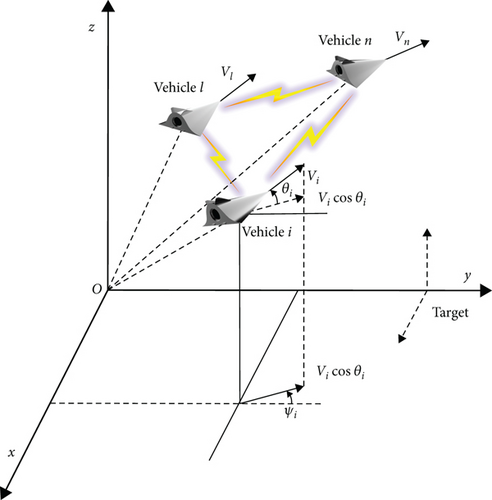
2.3. Multiple Constraints of Hypersonic Gliding Vehicles
This section provides a detailed explanation of both mission constraints and trajectory constraints, where the mission constraints encompass terminal constraints, control constraints, obstacle avoidance constraints, and collision avoidance constraints.
2.3.1. Terminal Constraints
2.3.2. Trajectory Constraints
2.3.3. Control Constraints
2.3.4. Collision Avoidance Constraints
2.3.5. Obstacle Avoidance Constraints
2.4. Control Objective
3. Formation Control Algorithm
Based on a control framework that is organized into two separate terms. Firstly, the distributed virtual controller is designed. Then, an actual control input solver is introduced to obtain the actual control inputs. Finally, a formation control algorithm is devised to consolidate all of the aforementioned aspects.
3.1. Distributed Virtual Controller
3.1.1. Construction of Objective Function
Every individual objective function is composed of a tracking index , a consensus index , an input index , and a terminal index for each HGV i ∈ ℕa.
3.1.2. Construction of Constraints
Remark 4. The problem of obstacle avoidance in this paper considers obstacle avoidance before the achievement of the desired formation configuration. Hence, the terminal constraints of HGVs are consistent with the obstacle avoidance constraints for the mission constraints, i.e.,
Assumption 5. The terminal set (36) is defined in a manner that ensures , i ∈ ℕa, and the terminal controller (19) is specifically devised to fulfill , , and i ∈ ℕa under all circumstances.
Problem 6. At time step k (i.e., t = T0 s), given ξi(k + l|k), , , i ∈ ℕa, and l = 0, 1, ⋯, N − 1, DMPC optimization problem is as below:
-
Algorithm 1: Distributed model predictive control algorithm.
-
Offline stage: for i ∈ ℕa, provided Pi, Qi, Ri, υi, , dij, , and Hi, determine Ki,1, Ki,2, Si, and Di. is delivered into mapped system (16).
-
Online stage: at the initial time step k = 0 when the current time is t = T0 s, wait for the initial optimal control inputs , l = 0, 1, ⋯, N − 1, and the initial optimal states , l = 0, 1, ⋯, N, for HGV i ∈ ℕa. There are four steps at online stage as follows:
-
Step 1. At time step k, k ≥ 0 for HGV i ∈ ℕa. Apply to compute the assumed control inputs together with the assumed states , l = 0, 1, ⋯, N, by Eqs. (18) and (20). Then, transmit , l = 0, 1, ⋯, N, to HGV and receive , l = 0, 1, ⋯, N, from HGV .
-
Step 2. At the next time step k + 1, k ≥ 0, for HGV i ∈ ℕa, the current states ξi(k + 1|k + 1) are sampled to compute μij(k + 1 + l|k + 1), μi(k + 1 + l|k + 1), l = 0, 1, ⋯, N − 1, , and νi(k + 1). Then, Problem 6 is solved to get the optimal control inputs , l = 0, 1, ⋯, N − 1, and the optimal states , l = 0, 1, ⋯, N.
-
Step 3. Apply and for the passing of virtual signals between the distributed virtual controller and the actual input solver.
-
Step 4. Return to Step 1.
Theorem 7. At every time step k, each HGV possesses the ability to optimize with a distributed manner using Algorithm 1 with a synchronous update strategy. Assuming Assumption 5 holds, if there is at least a feasible solution available for every HGV at the initial time step k (i.e., t = T0 s), all of the subsequent optimization problems will remain practicable. Moreover, every HGV converges to the expected formation configuration asymptotically while satisfying collision and obstacle avoidance constraints, stagnation point heating rate constraints, terminal constraints, and dynamic pressure constraints.
Proof. With the DMPC implemented by Algorithm 1. The optimization Problem 6’s recursive feasibility and the closed-loop system’s stability where system (16) adopted Algorithm 1 are analyzed, respectively.
- (1)
Feasibility: firstly, it is presumed that the optimization of Problem 6 for i-HGV is practicable at time step k. Accordingly, , l = 0, 1, ⋯, N − 1, is the optimal control inputs, and , l = 0, 1, ⋯, N, is the corresponding optimal states. Then, the assumed control inputs and the assumed states , l = 0, 1, ⋯, N − 1, can be calculated according to Eqs. (18) and (20). Taking the information discussed above into account, the feasible control input , l = 0, 1, ⋯, N − 1, and feasible state , l = 0, 1, ⋯, N, are introduced. Define and . Next, at time step k + 1, consider input sequence for HGV i. Applying to HGV i, the satisfaction of constraints (43) except follows directly from the assumed control inputs’ definition and Assumption 5. The positive invariance of the terminal set further results in the satisfaction of constraint . Therefore, the input sequence is a feasible solution to HGV i at time step k + 1, which means the feasibility of Problem 6 at time step k implies the feasibility at time step k + 1. Problem 6 is practicable at all future time instants by recursion
- (2)
Stability: the optimal cost summation for all the HGVs is defined as a Lyapunov function of the whole system, which is indicated by
Then, the summation of the costs is considered at time step k + 1 related to the feasible solutions for all the HGVs, represented by
For the ease of subsequent proof, the objective function to be optimized at every time instant for each HGV is built up of two components: stage objective function and terminal objective function .
The difference between the optimal objective function and the feasible objective function at two successive time steps is
Then, there have the following formulas:
Owing to the satisfaction of , there have
where and . From the definition of Ki,2 and Ki,1, there have . And . From Eq. (25),
Also, there have
Furthermore, define variables as follows:
Then, it follows that
where by the definition of νi(k), there have
Substitute Eqs. (52), (53), and (56) into (47). Given the solution’s optimality, the following result is derived accordingly:
Define 0 < υi < 1 as the convergence speed for closed-loop system. Then, the mapped multiple HGV systems converge to expected states influenced by the desired configuration asymptotically. Moreover, the terminal constraints, stagnation point heating rate constraints, dynamic pressure constraints, and collision and obstacle avoidance constraints will be obtained according to Theorem 7.
3.2. Actual Input Solver
According to Eq. (61), the bank angle σi can be ignored temporarily to decrease the complexity of calculation. Then, consider αi is implicit in terms of Di. Obviously, Li and Di are the function of αi. Although Vi also affects Li and Di, Vi of Li and Di are the same, which means that the actual input can be calculated inversely according to Eq. (61) by calculating and satisfying Eqs. (59) and (60).
In summary, the implementation procedure of the calculation for the actual inputs and is given as follows.
-
Procedure 1: Procedure of the calculation for the actual inputs.
-
Initialization: for HGV i ∈ ℕa, Step 3 of Algorithm 1 is completed. Then, the virtual control signals and are obtained accordingly. Denote as the states of multiple HGVs at current time t = T0 s. and are the actual inputs to be solved at current time t = T0 s.
-
Step 1. Substitute into Eq. (62) to get .
-
Step 2. is obtained by applying Di and into Eq. (63). Then, can be calculated by Eq. (64) with the knowledge of and .
It is noted that the constraint of aerodynamic load cannot be considered in the design of virtual controller because of coupling. To constrain the violation of the aerodynamic load, the following process are proposed.
In summary, suppose that Assumption 3 and Assumption 5 are both met in the distributed virtual controller, multiple HGVs’ formation control is achieved by the formation control algorithm exhibited in Figure 2.
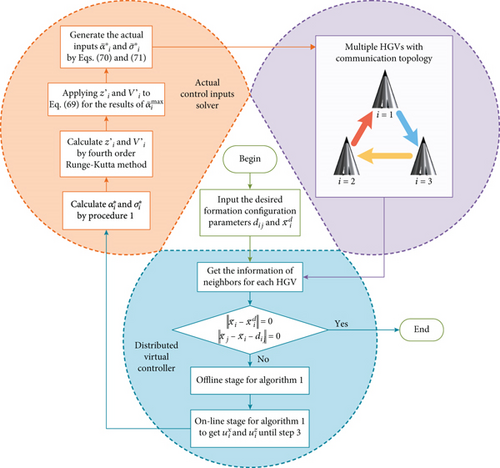
4. Simulation Examples
Three simulation examples are provided in this section: (1) simulation of formation accomplished with different control parameters, (2) simulation of formation control satisfying multiple constraints, and (3) simulation comparison with existing methods. Example 1 unveils the characteristic of the proposed algorithm by setting different control parameters and conservative constraint parameters. The desired formation achieved in example 1 serves as reasonable initial states for example 2 that will be studied in the middle of entry gliding phase. Then, the successful achievements of obstacle and collision avoidance for formation control while dealing with multiple constraints simultaneously are demonstrated in example 2. Examples 3 and 1 share the same initial states for multiple HGVs. After successfully demonstrating the characteristics of the proposed formation control algorithm in example 1 by setting various parameters, example 3 utilizes the same parameters from example 1 to compare with other algorithms, which exhibits superior performance compared to other existing formation control strategies for the multiple HGVs. Consider Na = 3. The simulations in this study utilize the CAV-H model [1]. Multiple HGVs’ communication topology is shown in Figure 2. Then, each HGV’s maximum maneuvering ability is limited by the limitation of the actual inputs, where , , , and . Define the formation error variables for xi and for zi.
4.1. Simulation of Formation Accomplished with Different Control Parameters
The initial states for the multi-HGVs are exhibited in Table 1. t ∈ [0, 60 s) is the initial phase where each HGV flies in maximum lift-drag ratio with αi = 10∘ and σi = 0∘. Then, the proposed algorithm is to be studied when t ≥ 60 s. The desired formation configuration is depicted in case 1 of Table 2. To unveil the characteristic of the proposed algorithm, various parameters which are vital are shown in Table 3. It is noted that to better illustrate the characteristics of the control performance, the investigations of collision avoidance, obstacle avoidance, and trajectory constraints are all ignored in this simulation by setting conservative constraint parameters. The rationale for conducting the simulation prior to the simulation in Section 4.2 is to establish reasonable initial states for the simulation that will be studied in the middle of entry gliding phase. The other parameters are selected as T = 1, δi = 0.1, τi = 0.1, υi = 0.9, , and .
| HGV i | xi (km) | yi (km) | zi (km) | Vi (m/s) | θi (°) | ψi (°) |
|---|---|---|---|---|---|---|
| i = 1 | −10 | 0 | 77.28 | 3717 | 0 | 90 |
| i = 2 | 0 | 0 | 79.19 | 3688 | 0 | 90 |
| i = 3 | 10 | 0 | 78.42 | 3701 | 0 | 90 |
| Term | Case 1 | Case 2 |
|---|---|---|
| HGV 1 |
|
|
| HGV 2 |
|
|
| HGV 3 |
|
|
| Term | Control parameters |
|---|---|
| Parameter 1 | P = diag{1, 1, 100, 100}, N = 5 |
| Parameter 2 | P = diag{1, 1, 100, 100}, N = 15 |
| Parameter 3 | P = diag{1, 1, 10, 10}, N = 15 |
Define case 1 as the desired formation configuration with control parameter 1, and case 2 and case 3 are defined similarly. Figure 3 shows the different formation flight trajectories from the proposed algorithm with different control parameters. The desired formation configuration can be successfully acquired with the proposed algorithm. Figure 4 demonstrates the histories of value and convergence rate for formation error variables, where and converge to a small constant with different convergence rate. Comparing case 2 with case 1, a bigger prediction horizon N brings a faster convergence rate. Comparing case 2 with case 3, a bigger weight matrix Pi also brings a faster convergence rate. Case 2 brings a faster convergence rate together with a higher control accuracy than case 1 and case 3.
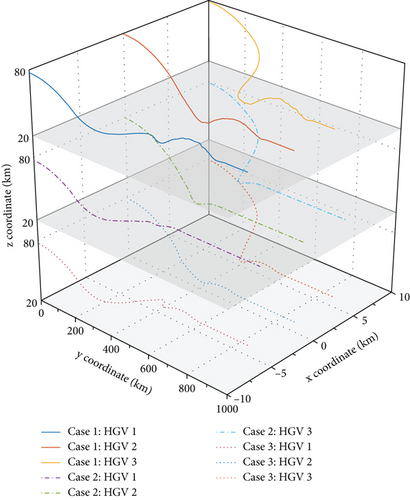
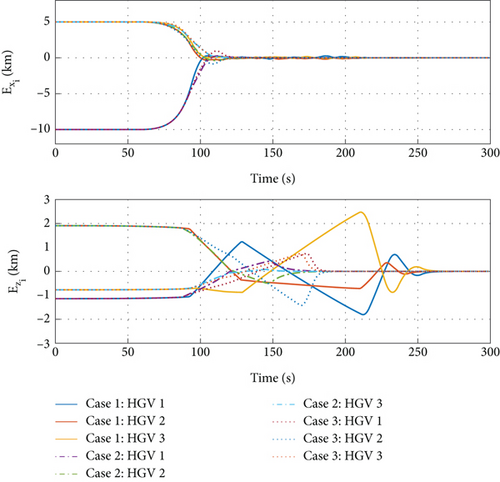
Figure 5 shows that the constrains of αi and σi are all satisfied in three cases. In Figure 6, time histories of Vi are given. From Figures 4–6, it can be seen that the increase of N and Pi not only increases the convergence rate but also decreases the energy consumed. However, a bigger N will bring higher computational load, and a bigger Pi may bring chattering problem for the actual control inputs. Thus, the selection of optimal parameters for N and Pi should be made by considering the actual circumstances.
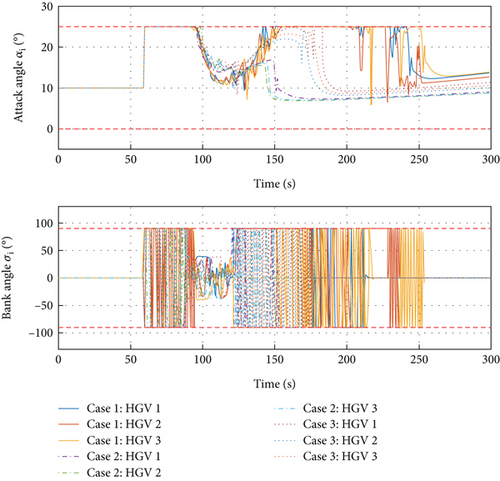
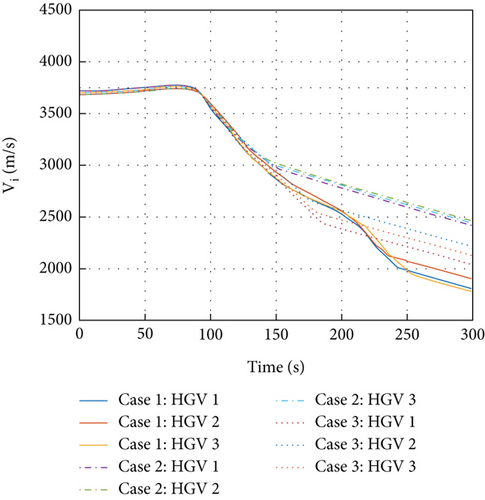
4.2. Simulation of Formation Control Satisfying Multiple Constraints
Then, the cardinal contributions of our work are the achievement for obstacle and collision avoidance for formation control while dealing with multiple constraints simultaneously. Therefore, this simulation uses three comparative experiments to reveal the function of the proposed algorithm. The initial states in this section are given in Table 4 according to Figure 6 in Section 4.1. Then, the desired formation configuration in this section is depicted in case 2 of Table 2. And the positions of obstacles are set in Table 5.
| HGV i | xi (km) | yi (km) | zi (km) | Vi (m/s) | θi (°) | ψi (°) |
|---|---|---|---|---|---|---|
| i = 1 | −5 | 0 | 33 | 2944 | 0 | 90 |
| i = 2 | 0 | 0 | 32 | 2958 | 0 | 90 |
| i = 3 | 5 | 0 | 31 | 2983 | 0 | 90 |
| Term | (m) | (m) | (m) |
|---|---|---|---|
| Obstacle 1 | -2100 | 32500 | 35000 |
| Obstacle 2 | 2800 | 31000 | 80000 |
The constraints of avoidance for both obstacle and collision are all included in three cases. In the presence of two obstacles, case 1 tends to achieve the desired formation configurations without considering the trajectory constraints for dynamic pressure, stagnation point heating rate, and total aerodynamic load. With the same goal as case 1, the total aerodynamic load is considered additionally in case 2. Finally, in case 3, which corresponds to case 2, both dynamic pressure constraints and stagnation point heating rate constraints are encompassed additionally. The constraints in Eqs. (6)–(8) are given as , qmax = 40 kPa, and nmax = 3. The other parameters are selected as T = 1, δi = 0.1, τi = 0.1, υi = 0.9, , , P = diag{1, 1, 100, 100}, N = 40, , and R = 1 km.
To begin with, Figure 7 shows the different flight trajectories of multiple HGVs of three cases. Figure 8 shows that and converge to zero, which means the goal of the desired formation configurations is achieved in spite of different constraints. Figures 8–15 analyze the three cases in detail. From Figure 10, collision avoidance is ensured; the relative distances between every HGV are greater than the safety distance 2R. In Figure 11, when t ≤ 15 s and yi ≤ 36000 m for each HGV, the relative distances between each HGV and obstacle 1 have a safety distance. In Figure 12, similarly, when t ≤ 35 s and yi ≤ 81000 m for each HGV, the relative distances between each HGV and obstacle 2 have a safety distance as well. Meanwhile, Figure 9 shows the histories of αi and σi, where the constraints of the maximum value are satisfied. The mission constraints are satisfied successfully by the proposed algorithm in case 1, case 2, and case 3.
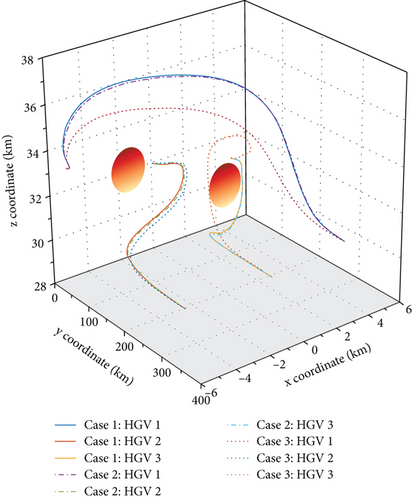
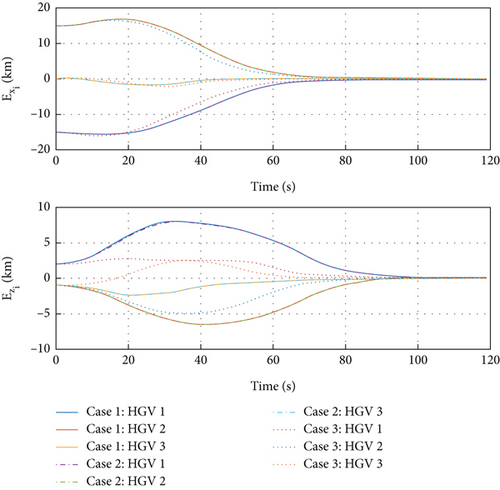
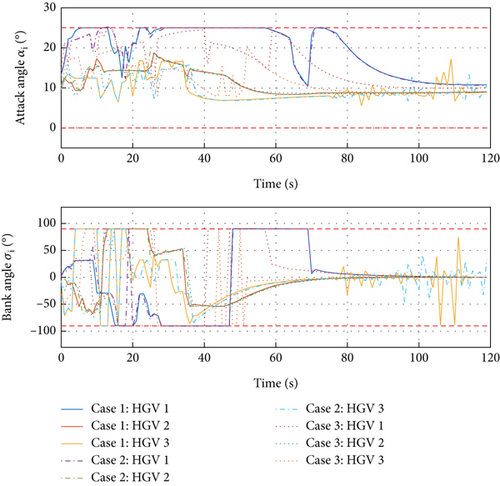
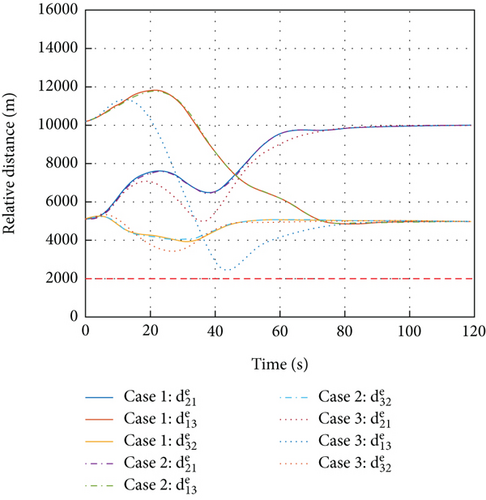
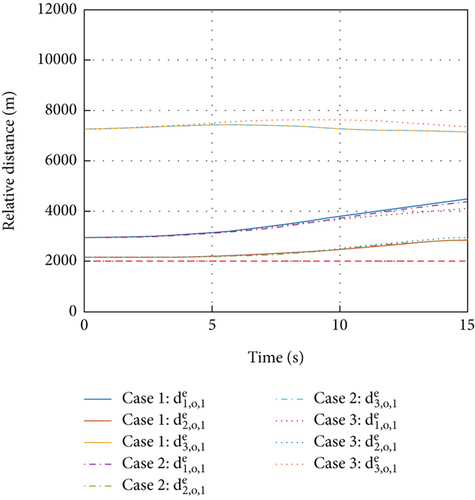
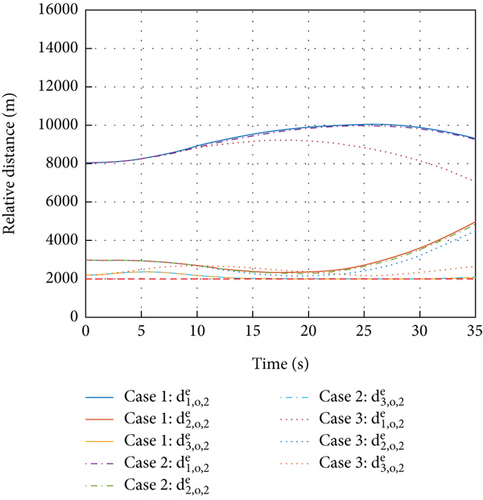
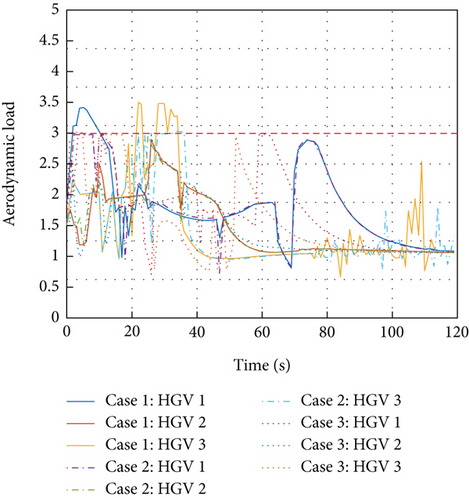
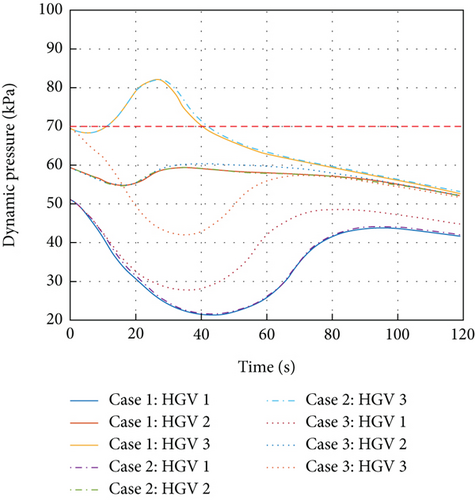
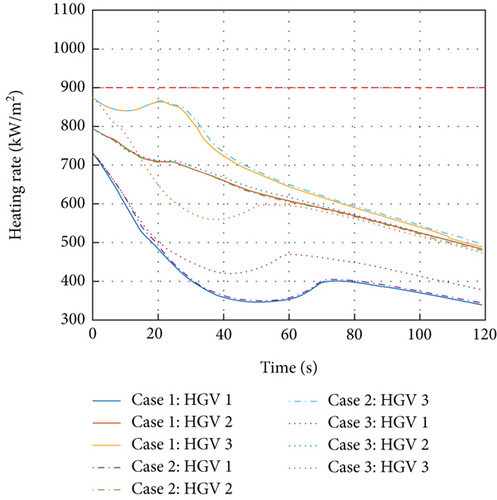
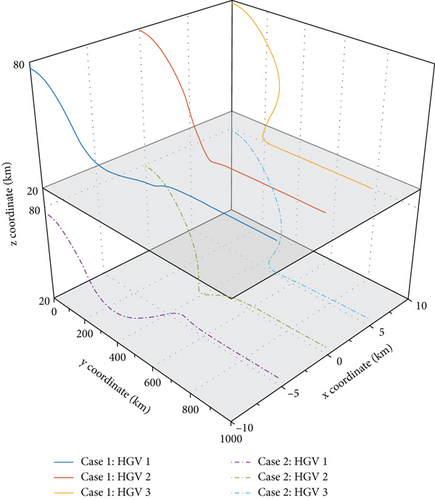
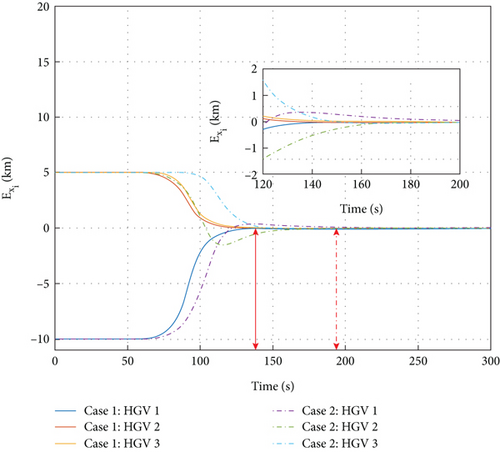
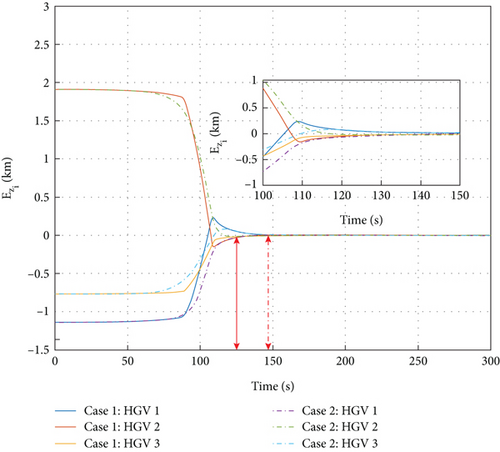
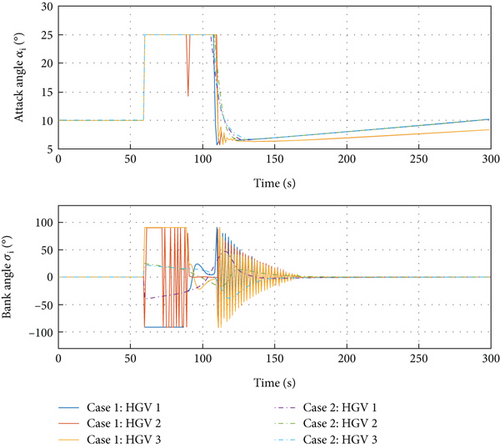
Moreover, the trajectory constraints’ satisfaction is analyzed with the mission constraints’ satisfaction. For case 1, Figure 13 shows that the aerodynamic load constraints are violated. In case 2, the aerodynamic load has a maximum value of 3, which means the aerodynamic load constraints are satisfied by the proposed algorithm. Although the trajectories of case 1 and case 2 are almost identical as exhibited in Figure 7, the aerodynamic load constraints should be considered seriously. Case 3 and case 2 both satisfy the aerodynamic load constraints as shown in Figure 13.
In Figure 14, both in case 1 and case 2, the dynamic pressure constraints are violated. Comparing case 3 with case 2, Figure 7 suggests that the significant change of the trajectory for multiple HGVs is the trajectory of HGV 2. To avoid the obstacle 2, HGV 2 flies beneath the obstacle in case 2 but flies above the obstacle in case 3 to achieve the obstacle avoidance. From Figure 14, the proposed algorithm enables HGVs flying with different trajectories with obstacle avoidance, which makes the violation of dynamic pressure constraints disappear in case 3. Hence, the multiple constraints are satisfied simultaneously in case 3. One thing worth noting is that the stagnation point heating rate is all satisfied in three cases. Although the simulation does not give a contrast example to show the suppression of stagnation point heating rate constraints violation as displayed in Figures 13 and 14, the state constraint set designed in Eq. (37) and the satisfaction of Assumption 5 make the suppression of dynamic press constraints equally persuasive towards the stagnation point heating rate constraints as exhibited in Figure 15. In summary, the aforementioned results convincingly unveil the proposed formation control algorithm’s strong performance in handling multiple constraints.
4.3. Simulation Comparison with Existing Approaches
Finally, to verify the proposed control algorithm’s superiority despite its ability to deal with multiple constraints. The comparison simulation is performed in this section. An insightful study for multiple HGVs is shown in [19], where a globally fixed-time formation control algorithm with the hierarchical control theory is introduced named fixed-time formation control, which ensures the fixed-time stability. Meanwhile, the proposed algorithm is named DMPC formation control to make comparison.
The initial states as demonstrated in Table 1 and the initial phase are the same as in Section 4.1. The desired formation configuration is given in case 1 of Table 2. The parameters for the two methods are shown in Table 6. In this section, to make better comparisons by control variates, the proposed control algorithm does not consider the constraints discussed in Section 4.2. Thus, the obstacle avoidance constraints, the total aerodynamic load constraints, the collision avoidance constraints, the stagnation point heating rate constraints, and the dynamic pressure constraints are all ignored by setting conservative constraint values for the proposed algorithm. The other parameters are selected as T = 1, δi = 0.1, τi = 0.1, υi = 0.9, , and .
| Term | Parameters |
|---|---|
| Fixed-time formation control | k1 = k2 = k3 = k4 = 0.01, p = 11, q = 13 |
| DMPC formation control | P = diag{1, 1, 100, 100}, N = 30 |
Figure 16 shows the comparison of the formation flight trajectories, which demonstrates the achievement of the desired formation configuration using the fixed-time formation control and the DMPC formation control. In Figure 17, time histories of the formation error variables are displayed; it can be seen that converge to the vicinity near zero within 140 s under the DMPC formation control. And converge to the vicinity near zero after 200 s with the fixed-time formation control.
It can be seen in Figure 18 that converge to the vicinity near zero within 130 s under the DMPC formation control and converge to the vicinity near zero within 150 s under the condition of the fixed-time formation control. From Figures 16–18, DMPC formation control gives a faster convergence rate and smaller steady-state value for formation error variables than the fixed-time formation control. Regarding the fixed-time formation control, the formation error variables have a faster convergence speed which is illustrated in [19] by comparing with classical and finite-time formation control. Therefore, the DMPC formation control has a relatively fast convergence speed rather than the fixed-time formation control and a rapidly faster convergence speed and improved convergence precision rather than other methods. In Figure 19, the maximum maneuvering ability is the same for the two methods, where the limitations of the αi and σi are the same and are satisfied during the formation control. Accordingly, the simulation illustrates that in spite of the ability to cope with multiple constraints during the formation flight, the proposed formation algorithm has a superiority in convergence speed and convergence precision. The proposed formation algorithm exhibits superior performance compared to other existing formation control strategies for the multiple HGVs.
5. Conclusion
In our work, a distributed formation control algorithm is investigated for multi-HGVs under multiple constraints consisting of mission constraints and trajectory constraints. The first difference between previous algorithms and the proposed algorithm is the fulfilment of the obstacle avoidance constraints, the collision avoidance constraints, and the terminal state constraints for the mission constraints for multiple HGV formation flights. The second difference is that, with the satisfaction of the necessary mission constraints, the trajectory constraints were considered additionally the first time for the formation flight of multi-HGVs. A distributed virtual controller and an actual control input solver were designed for the control framework, where the virtual controller introduced an optimization problem with a synchronous update strategy for the formation control in a distributed way and the actual control input solver adopted a novel solution process to calculate the actual control inputs while dealing with multiple constraints. Extensive simulation results disclose that the proposed algorithm has the ability to guarantee multiple constraints for formation flight with obstacle and collision avoidance simultaneously. And the superiority in the control performance is demonstrated.
Conflicts of Interest
The authors declare that there is no conflict of interest regarding the publication of this paper.
Acknowledgments
This work was funded by the National Natural Science Foundation of China (grant number 61473229).
Open Research
Data Availability
The data used to support the findings of this study are available from the corresponding author upon request.




